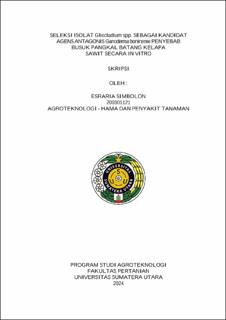Seleksi Isolat Gliocladium Spp. sebagai Kandidat Agens Antagonis Ganoderma Boninense Penyebab Busuk Pangkal Batang Kelapa Sawit secara In Vitro
Selection of Gliocladium spp. Isolates as Candidates for Ganoderma Boninense Antagonist Agents Causes Oil Palm Basal Stem Rot In Vitro

Date
2024Author
Simbolon, Esraria
Advisor(s)
Safni, Irda
R, Tjut Ahmad Perdana
Metadata
Show full item recordAbstract
Basal stem rot (BSR) caused Ganoderma boninense is an important disease of oil palm plants that can cause economic losses. Various methods of controlling G. boninense in oil palm plants have been carried out but have not provided satisfactory results. The use of antagonist agents is one of the environmentally friendly controls for G. boninense. Until now, not much research has been carried out regarding the control of G. boninense using Gliocladium spp. This research aims to obtain isolates of Gliocladium spp. the most effective way to control G. boninense which causes root rot of oil palm stems in vitro. This study used a completely randomized non-factorial design with treatments namely G. boninense (control), G. boninense + G. virens, G. boninense + G. aureum, G. boninense + G. roseum, G. boninense + G. catenulatum, G. boninense + Gliocladium sp. The research results showed that each treatment had a different inhibitory power. The highest inhibitory power was found in the . boninense + Gliocladium sp. treatment with an average of 80.39% in the double culture test and 60.56% in the volatile test. The highest growth rate was found in Gliocladium sp. (90 mm) and the highest spore density was found in G. aureum isolates (5,56×108 conidia/mL). Based on the Bavendamm test, G. boninense which was treated was unable to grow and did not form a brown zone. It can be concluded that Gliocladium sp. is the best isolate for controlling G. boninense in vitro.
Collections
- Undergraduate Theses [3388]
